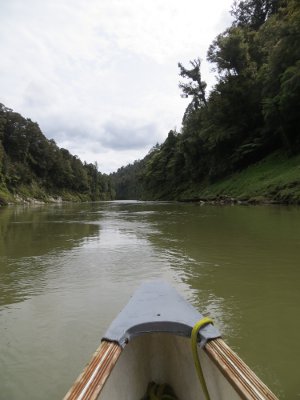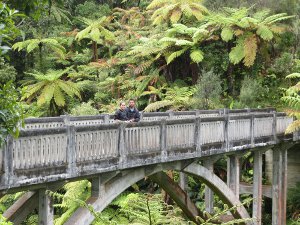Whanganui River Journey
New Zealand has several different multi-day backpacking hikes. There are eight specifically named the New Zealand Great Walks. We enjoy backpacking in the wilderness and at a minimum one of these Great Walks was a must for us. We decided to go with the one that is fairly unique compared to the rest of them, The Whanganui River Journey. This Great Walk entails a multi-day canoe ride down a river.
We were both a little hesitant about doing this journey, since neither of us had ever paddled down a river before. The only experience was a small concrete canoe competition Sal had in college, but not paddling in the wilderness. We went ahead with it after finding out that no prior experience was necessary.
The river journey lasted three days winding through mountains and forests. Most of the river lies inside the Whanganui National Park. The Maori, the indigenous people of New Zealand, believed that every river bend had a guardian which controlled the life force of that place. The total adventure was 87 km (54 miles) long, starting in Whakahoro and ending in Pipiriki.

We rented a canoe and all the accessories needed in the city of Ohakune. We were then dropped off into the river at Whakahoro. The same day there were a few other people that were starting the journey with us: Gerardo from Mexico was on a kayak; Dmitry from France was also on a kayak; Paul and Jennifer from the USA were on a canoe; and Richard from England and Alex from the Netherlands were also in a canoe.


Our first day of paddling felt as we were one with the river. Witnessing the peaceful, beautiful landscape made us believe there really was a life force. We passed by several small waterfalls and wild goats that would watch us pass by. Most of the day was partly cloudy and calm, which made ideal conditions to relax and just paddle every once in a while. The only problem we faced was not having enough wine! We spent the first night in bunk beds at John Coull hut. The hut included toilets, beds, and a kitchen that were well maintained and very clean.


The second day started off with cold rain. We had to paddle continuously in order to stay warm. We did get a chance to admire a family of ducks swimming alongside of us. There was a momma duck, papa duck, and four baby ducks with one of them trailing behind trying to swim fast to catch up to his family because he was scared of us. Our first stop for lunch normally takes three-and-a-half hours, but because we were paddling so much we did it in two-and-a-half hours. By the time we had stopped the rain had calmed down and we decided to take a forty-minute hike to the Bridge to Nowhere to have lunch. The weather continued to cooperate for the afternoon hour-and-a-half paddle to Tieke Kainga hut, where we spent the night. Tieke Kainga is home to a Maori marae, or religious meeting place, and we were told that if there were any Maori at the time we arrived they would greet us and would have to participate in a powhiri, or Maori welcome. We were disappointed that there were not any Maori there to greet us.


Our third and final day started off by having to take out a lot of water that had entered our canoe while dragging it into the river. After successfully clearing the canoe, we paddled calmly for a couple hours until we confronted a windstorm and it became difficult. When we paddled it seemed as if we weren’t moving much and if we stopped we would actually go backwards. It took us a long time to get to our final destination of Pipiriki that we thought we had missed the sign for it, but once we saw the sign we were relieved to know we didn’t have to be rescued!
Although there were a few times when the weather was not ideal, the experience of being alone with the Whanganui River and Mother Nature was irreplaceable. We had the opportunity to listen to the sounds of the river life force in many ways: tranquility, rain touching the river water, and the whistling of the canyon winds. The three-day journey was a chance to participate in New Zealand’s most unique Great Walk.
Walking to our Canoe
Paddling on the Whanganui River
